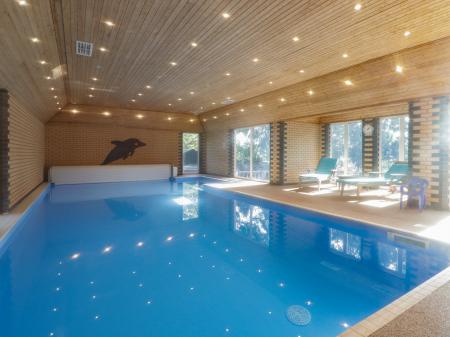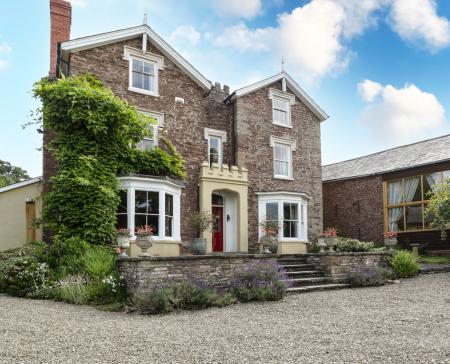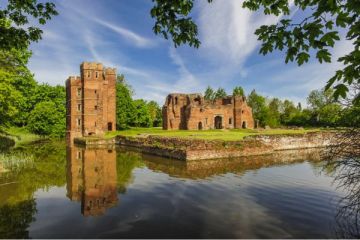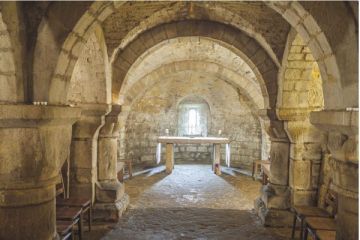The Black and White Villages Trail is a self-guided circular driving route through northern Herefordshire, taking in some of the most picturesque villages in the county plus the historic market towns of Leominster and Kington. The route covers roughly 40 miles (64km) and makes for a wonderful day's excursion.
You can pick up a Trail leaflet at local businesses and tourist information centres across the region, or simply follow the brown tourist signs marked with the symbol of a timber-framed building.
'Black and White' refers to the large number of picturesque timber-framed buildings that have survived in this peaceful rural area. Age-blackened timbers provide the 'black' and the 'white' comes from the plastered infill between the timbers.
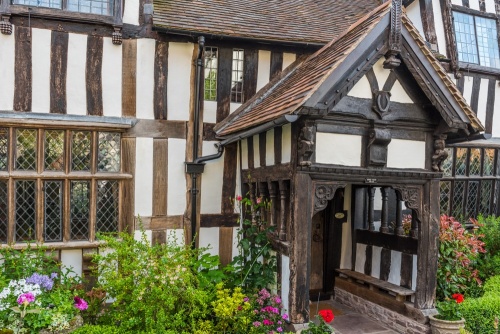
Traditional timber-frame construction used green wood, usually oak. The wood was used without drying because in its freshly-cut state it could be bent to the precise shape needed, making them easy to work with.
The drawback was that when the timbers dried they tended to warp and twist. That is why you will often see medieval timber-framed buildings skewed to one side or leaning at an alarming rate. Timbers were usually connected with mortise and tenon joints or with simple wooden pegs.
The spaces between timbers were filled in with lath and plaster - interwoven branches or strips of wood covered by plaster. These plastered panels were often limewashed, giving them a white finish. Timbers were usually left untreated and allowed to age naturally.
The idea of painting the timbers black to emphasise their contrast to the white panels is a recent one and one that the original house builders would have found puzzling. In the Georgian period many timbers were plastered over. It is only in the past century as fashions changed again that these buildings have had their plaster removed to expose the timbers once again.
Timber-frame construction was used for both private dwellings and for public buildings. Some of the most impressive surviving timber-framed buildings are market halls, such as Grange Court in Leominster.
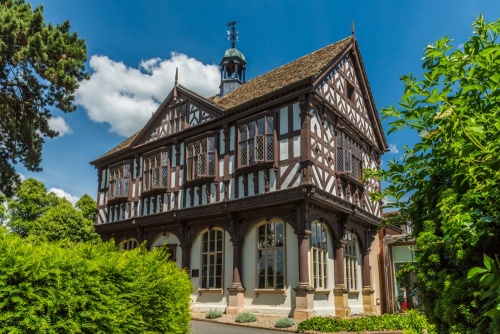
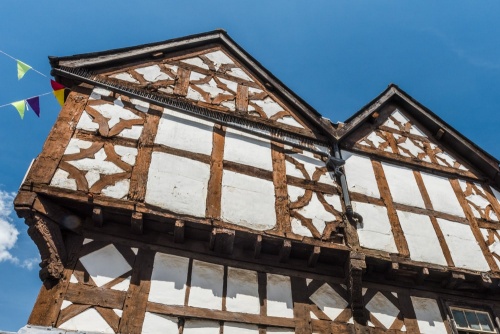
The Black and White Trail starts and ends in the historic market town of Leominster (pronounced 'Lemster'), which grew up at the confluence of the River Lugg and the River Kenwater. The town dates to at least the 7th century and grew wealthy during the medieval period from its wool trade, made possible by the high-quality wool produced by the local Ryeland sheep.
The town is full of attractive timber-framed buildings, many of them clustered around the market place of Corn Square.
A short walk from the market brings you to Leominster Museum on Etnam Street, housed in three historic buildings including a Victorian stable and a Georgian cider mill. Inside the museum you can trace the town's history and see local finds including the Bronze Age Aymestrey Burial. There is a special display of artwork by John Scarlett Davis, who was born and lived locally. See a recreated 19th-century schoolroom and artefacts from the Leominster and Kingston Railway.
A short walk from the museum brings you to Grange Court, built in 1633 as the town's market hall and now the towns official symbol. This exquisitely decorated timber-framed building is not actually a 'black and white' structure but 'brown and white' as the timbers are all painted an earthy tone rather than black. That doesn't detract from the superb carving detail, however. Grange Court was the work of John Abel, who was so skilled that he was given the title of 'King's Carpenter' by Charles I.
Grange Court stands on the edge of Priory Gardens, a public park formed from the former medieval priory on this site. The monastic church now serves as the parish church and boasts the last ducking stool to be used in England.
Three miles north of Leominster is Berrington Hall, a beautiful Georgian mansion set in parkland laid out by Capability Brown for a wealthy merchant named Thomas Harley in 1783. The house was designed by Brown's son-in-law Henry Holland and boasts an outstanding collection of fine furniture and artwork.
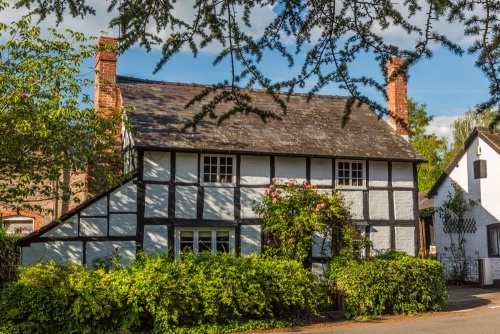
From Leominster the Trail follows the A44 to the pretty village of Dilwyn. Black and white cottages cluster around the wide village green. On the north side of the green is Karen Cottage, built in the 17th century and now divided into three separate cottages. At one end of the green is the Old Forge, now an art gallery and tea shop.
A few steps away is the Crown Inn, which made the news in 2012 when the parish council bought it when it was threatened with closure. It is thus the only council-owned pub in Herefordshire.
On the village green look for a memorial to Pilot Officer John Pugh of the RAF who died in a plane crash in Dilwyn in May 1940.
Soaring over the village is the spire of St Mary's Church, dating to the late 12th century. The church boasts the 14th-century effigy of a knight, thought to be Sir George Talbot, who died in 1387.
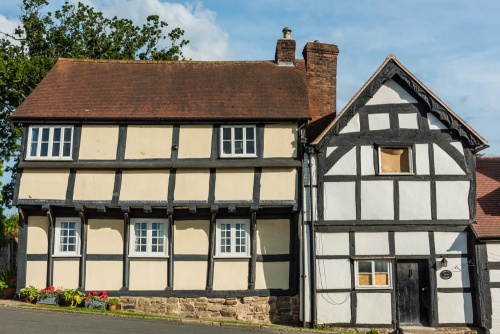
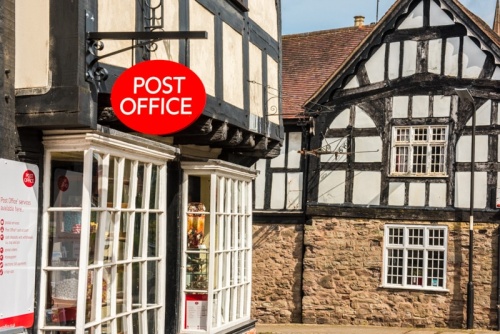
From Dilwyn take the A4112 to Weobley (pronounced 'Webbly'), one of the prettiest villages in Herefordshire. A recent poll by the Daily Mail newspaper named Weobley as one of the 20 most idyllic villages in Britain and the estate agency Savills named it in the top eight most desirable villages in Britain.
The village grew up in the Saxon period and we know that there was a church here at the time of the Norman Conquest in 1066. The present medieval parish church of St Peter & St Paul dates to the 13th century and is visible across the fields for some distance due to its striking spire - the second-highest in Herefordshire. Historical treasures inside the church include three 15th-century effigies. One of the effigies commemorates Sir William Devereux, who was killed during Owain Glyndwr's rebellion in 1402.
Just south of High Street are the earthworks of Weobley Castle, erected during the turbulent Anarchy, the civil war between supporters of King Stephen and Queen Maud in the middle of the 12th century. King Stephen captured Weobley Castle in 1140 and all that is left today are earthwork walls and ditches.
Weobley's attractive High Street is lined with picturesque timber-framed buildings including the Red Lion Inn at the bottom of the street and the Salutation Inn at the top. A Heritage Trail links some of the best historic buildings, including a house where Charles I slept after the Battle of Naseby during the Civil War.
You can learn more about Weobley's history at the town museum on Back Lane.
From Weobley return to the A4112 and turn left towards Brecon. In a few miles you will pass through the village of Sarnesfield. In the churchyard is the grave of John Abel, the King's Carpenter who built Grange Court in Leominster and was responsible for numerous other timber-framed buildings around Herefordshire.
The church itself dates to the 12th century and boasts a marble monument to Bridget Monnington (d 1775) and an 18th-century funeral hatchment to another member of the Monnington family.
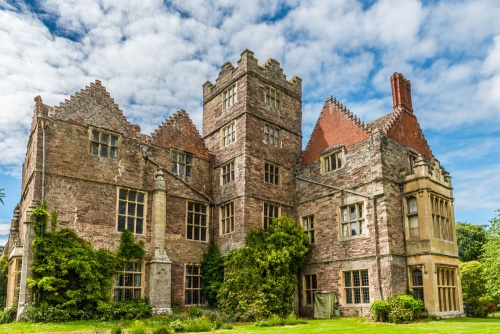
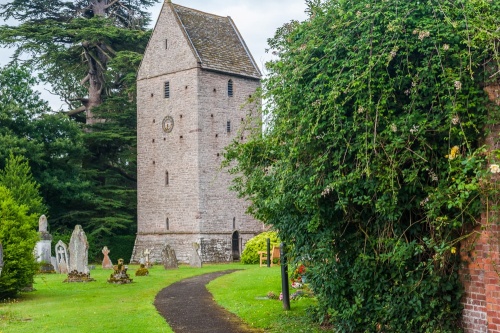
Carry on westward along the A4112 and in two miles you come to Kinnersley. Just before you reach the village you will see Kinnersley Castle on your right. The castle began as a Norman fortress but was remodelled into a Tudor manor house by Roger Vaughan from 1585. Architectural historian Simon Jenkins once called Kinnersley Castle 'as architecturally important as Buckingham Palace', and he is right.
The castle is now a rambling Tudor, Jacobean and Victorian house incorporating original medieval features. The result is one of the most interesting and historically important historic houses in Britain.
The castle interior features very fine plasterwork ceilings and oak-panelled rooms. The finest room is the solar, with an ornate gilded plasterwork ceiling installed in 1588. Remarkably, the roof tiles are original and rest on Elizabethan split-oak lathes.
You can still see traces of the medieval moat, now filled in, and in the garden is one of the oldest and largest Gingko trees in the country. The castle is open on specified days throughout the year for extremely enjoyable guided tours with the owner.
Beside the castle stands St James' Church, built in the 13th century and featuring a saddleback west tower. Historical highlights include a painted and gilded memorial to Francis Smallman (d 1633) the lord of the manor of Kinnersley. Smallman served as an MP under both James I and Charles I. Beneath the memorial is a brass commemorating a former rector who died in 1421.
The interior of St James' Church was heavily restored in the late Victorian period by the architect GF Bodley, who married the daughter of the Kinnersley Castle owner. Bodley spent 30 years lovingly restoring the church and the interior painted decoration is his work. Bodley and his wife are buried in the churchyard.
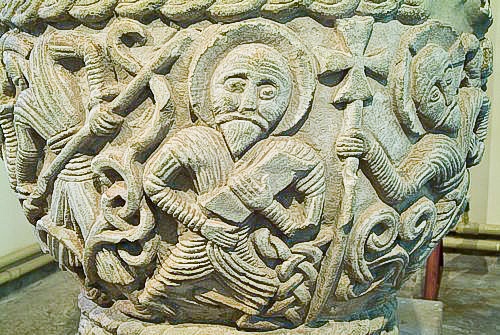
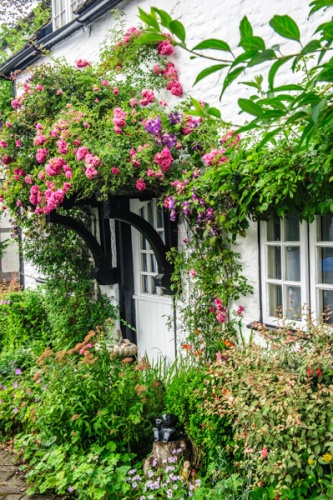
From Kinnersley follow the A4112 for two miles and turn right on the A4111 towards Rhyader. You will immediately find yourself entering the picturesque village of Eardisley.
On your left is St Mary Magdalene Church, built in the 12th century and featuring one of the most remarkable Norman fonts in England. The font is shaped like a chalice, or goblet, and is carved on both the base and the bowl with intricate patterns of figures, writhing vines and foliage, and geometric patterns.
The carvings depict the story of a sinner saved from evil in the form of a lion by the figures of Christ and the Holy Spirit. another part of the font depicts two knights in combat. The knights are thought to represent Lord Drogo of Clifford and his son-in-law, Ralph de Baskerville of Eardisley. The pair fought over a land dispute in 1127 and Lord Drogo was killed.
De Baskerville was full of remorse and became a monk at Gloucester Abbey. He may have hired the masons who carved the font as an act of atonement. Those same masons, known as the Herefordshire School, also carved the extraordinary figures at Kilpeck and Shobdon.
Carry on past the church and you pass beautiful timber-framed buildings along the main street. In the village centre is Tram Square, so named because the horse-drawn tramway linking Kington and Brecon ran through the village from 1818 until it was superseded by the railway.
Take a short detour up the lane beside the Tram Inn in the direction of Wood Eaves. after 1 mile turn right at a chapel and you will find The Great Oak of Eardisley. The hollow oak tree is thought to be 900 years old and is one of the oldest trees in Herefordshire.
Return to Tram Square and turn onto the A4111 once more. Follow the road to Kington, an attractive town on the Welsh border.
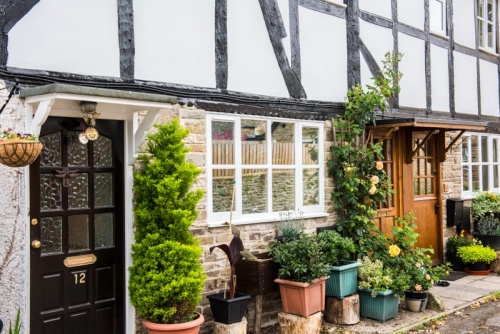
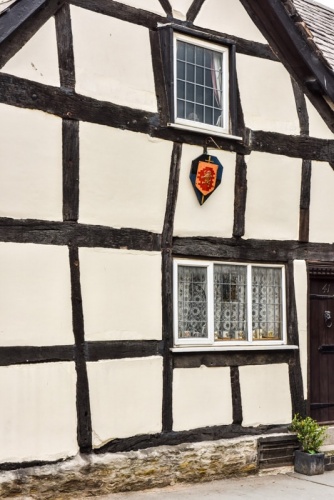
The town grew up at the confluence of the River Arrow and Cynon Brook. It is a popular centre for walkers, with no less than four long-distance walking trails passing through the town. Not surprisingly, it is home to an annual walking festival. A very good Heritage Walk links historic sites around Kington including the terminus of the Kington Tramway. The trail passes the Oxford Arms Hotel on Duke Street, with its roots in the 13th century.
At Upper Cross is the iconic Town Clock and the market hall, built to celebrate Queen Victoria's Diamond Jubilee. Walk up Church Street and you come to The Square, where a horse fair was held as early as the 13th century.
At the top of the hill is St Mary's Church, built around 1200. The church has a detached bell tower which served as a place of refuge during times of trouble. The most interesting historical feature inside the church is a 12th-century font decorated with cable moulding.
Look for the ornate tomb of Sir Thomas and Lady Ellen Vaughan of Hergest Court in the south chapel. Sir Thomas was known as 'Black Vaughan' -- not for his temperament but for his hair colour. When he died at the Battle of Banbury in 1469 his headless body was brought back to Kington.
Legends began to arise after his death, and it was said by townsfolk that Vaughan appeared as a huge black bull and a fly that tormented horses. It took a dozen clergymen to trap Vaughan's restless spirit in a snuff box that they buried at the bottom of Hergest Pool.
Lord Thomas' companion was said to be a large black dog, whose spectre haunted the Vaughan family for generations. The dog was said to appear before a Vaughan family member to signify their imminent death. In later years Sir Arthur Conan Doyle visited Hergest Court where he heard the legend of the Black Dog of Hergest. He was inspired by the tale to write his Sherlock Holmes adventure, The Hound of the Baskervilles.
Today you can visit Hergest Croft to enjoy the superb gardens, with colourful azaleas and rhododendrons in spring and rich golden colours in autumn from a large number of birch and maple trees.
From Kington take the A44 signposted towards Leominster. Just outside the town you will pass Penrhos Court, an attractive complex of 14th-century timber-framed buildings now operating as holiday cottages. You will quickly reach Lyonshall.
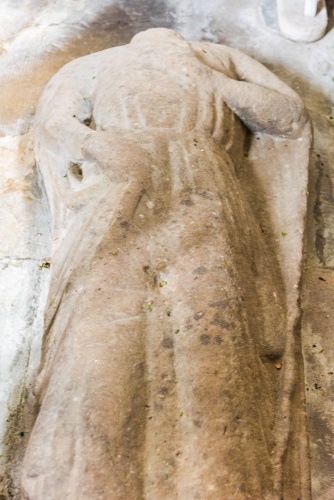
The medieval parish church of St Michael is on the main road, but the village itself is 1/2 mile away on the A480. Why the distance between the two? It seems that the village was hit hard by the Black Death in 1348-50. Those villagers who survived rebuilt well away from the former village site, leaving the church stranded.
It is well worth exploring the church, which stands beside the site of 11th-century Lyonshall Castle. In the north aisle is a worn stone effigy dating to the 13th century. The font is also 13th century and is carved in a peculiar octofoil design. Look for wall tablets to Richard Hooper (d 1784) and John and Anne Muscott (c. 1782).
Carry on along the A44 and you come to Westonbury Mill Water Gardens, a modern 8-acre garden surrounding a picturesque mill building. The garden is dotted with picturesque follies and features like a water tower linked to a water wheel. A system of buckets on a continuous loop fills a tank at the top of the tower with water from the mill stream. When the tank is full the water runs out through a whimsical gargoyle carving.
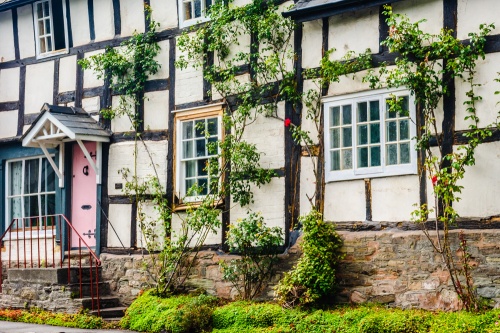
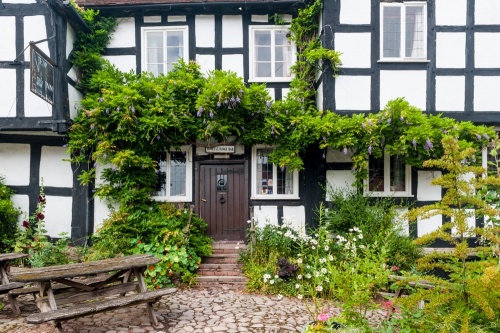
Continue along the A4 and you reach Pembridge, another village famous for its large number of picturesque timber-framed buildings. among them a pair of 17th-century almshouses. One of the almshouses was built by Alice Trafford, whose tomb is in the attractive parish church of St Mary.
The church is known for its unusual detached bell tower, built in the early 13th century, which makes it one of the oldest surviving timber-framed buildings in Britain. Behind the church you can see traces of the most that surrounded Pembridge Castle. Of the castle itself only a low earthen mound remains.
The village dates to the Saxon period and was mentioned in the Domesday Book of 1086. It grew up along the River Arrow and villagers used river water for drinking until 1960. It gained the right to hold two annual fairs in 1239. Pembridge became a trading centre for English and Welsh wool merchants, who met at the timber-framed market hall. Lining the main street are at least 8 medieval hall houses and a large number of 15th-century cottages.
From Pembridge you can take a short detour up the minor road to Shobdon. Just north of the village is the historic parish church of St James. Though the church exterior is medieval, the interior is pure 'Strawberry Hill Gothick' theatre, an extravagant Georgian palette of white and pale blue design by the Bateman family of Shobdon Court.
The Batemans were friends with Horace Walpole, whose extraordinary Gothic design for his own house at Strawberry Hill, Twickenham, inspired them to create their own version on a smaller scale. The highlight is an outlandish three-storey pulpit.
When the Batemans remodelled the church interior they removed many of the medieval features including several beautifully carved arches, and reassembled them on to of the neighbouring hill. The Shobdon Arches, reached by a long avenue of trees, were the work of the same Herefordshire school of masons responsible for Kilpeck church and the font at Eardisley.
Returning to Pembridge follow the A44 east to a minor road on the left signposted to Eardisland.
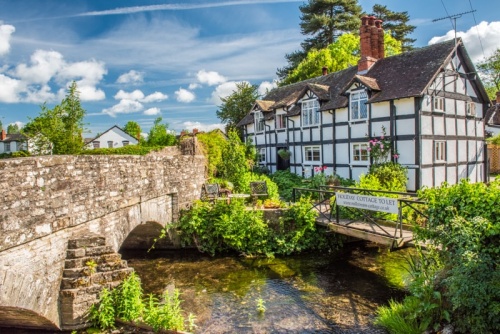
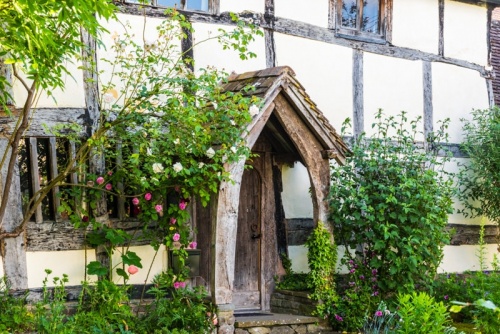
This beautiful village is perhaps the most attractive in Herefordshire, if not all of England, with a very large number of 'black and white' timber-framed cottages, many of them thatched. The village grew up beside the River Arrow and its name comes from 'Earl's Lene', a 'lene' or low-lying valley belonging to an earl. In this case the earl was Morcar, the Earl of Northumbria, who held the estate at the time of the Norman Conquest.
The Eardisland estate was at various points in its long history held by William the Conqueror, William de Braose, the powerful Mortimer family of Wigmore, Richard, Duke of York, Catherine of Aragon, Mary I, and Robert Devereux, Earl of Essex and favourite of Elizabeth I.
The most eye-catching building in Eardisland is not timber-framed; it is the village-owned 17th-century brick dovecote, which now houses the village shop and an exhibition of local history. The local church of St Mary dates to the early 13th century and boasts a late-medieval parclose screen and a 14th-century grave slab. Behind the churchyard are the moated remains of a Saxon castle, perhaps erected by Earl Morcar.
The oldest house in the village is Knapp House, a 14th-century cruck-framed hall house. On the north bank of the river is Staick House, also 14th century, but perhaps the prettiest timber-framed house is Mill Stream Cottage, opposite the dovecote on a small island in the river.
From Eardisland return to the A4 and turn east towards Leominster. After three miles you can detour to Kingsland, a large village with a number of timber-framed houses. Kingsland is home to Border Oak, a company making black and white timber-framed buildings using traditional construction techniques.
Return to the A44 and you will reach Leominster after one mile.
And there you have it, a circular tour taking in some of the most idyllic and picturesque villages you can imagine, full of traditional black and white timber-framed buildings. If I was pressed, I'd say my favourite village was Weobley. Or Dilwyn. Or Eardisland. In truth, I can't decide; they're all beautiful and all worth visiting. Enjoy!
MOST POPULAR POSTS
